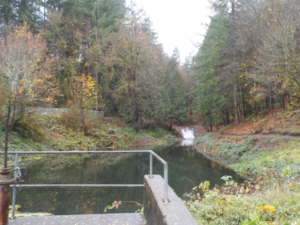The Nisqually River Education Project, South Sound GREEN and Chehalis Basin Education Consortium are offering the first ever Climate Resiliency Fellows. This program aims to build a dynamic community of engaged teachers committed to engaging their students in learning about and taking action in local climate change issues and climate resiliency projects. The Fellows program is offered as a part of a 3 year, environmental literacy program supported by NOAA. Teachers in the program meet quarterly to receive curriculum support and brainstorm ideas for action projects that address local issues. Lourdes Flores Skydancer is one of our Fellows this year and is continuing to actively engage her students outdoors! Here is their second blog post detailing their experiences with Water Quality monitoring; thanks Lourdes!
December 2016
Time to go out and check out the river!
We first walked to the place where we can see the waterfall. Impressive! Massive amounts of water falling down with a comforting yet imposing sound. We look at the beautiful waterfall and wonder where it all start? We know the water comes from the glaciers of the mountains, we had learned that a couple of weeks before, when we visited Mt St Helens. We could see the water was coming down from the mountain! Where does it go from here? We followed the water into the river, and into the creek, Shelton Creek. It winds through houses and parks along town. Sometimes, it seems that it disappears. We realized then that parts of the creek are underneath the town! We keep following it. We stopped only at the designated stop where we are taking the samples. It has to be a spot where we can safely pick up a bottle of water without falling into the water!
We found a spot. Rachel, our leader and teacher, explains to us that we will collect water in a bottle that we brought from the classroom. She also carries a small bottle where she is going to collect a special sample. We quickly gather the water in the bottles. But Rachel with her long rubber boots goes into the creek a little bit, so she can fill in the little bottle, submerged, until the rim, without letting any air in. She explains we will measure dissolved oxygen and we can not let any oxygen from the air enter into our bottle.
Then, she had us observe the conditions of the creek, are there any trees around here? She asks, -what about shrubs? Dead leaves on the water? Are there animals in the creek? What about nearby? Are there man-made structures?
That was when we realized how the surroundings affect the creek! In this part of the creek, the trees have been left natural, they cover the creek with their shade, which is healthy for the salmon, since they provide a shade that keeps the temperature of the water lower, which is good for the salmon.
We observed other natural items and also man made structures. We, took notes and walked back to our classroom to analyze the water. We would conduct four tests: dissolved oxygen, nitrates, temperature, turbidity and pH.
We concluded that our creek has very clean water. We are happy with the results!
Now we know that we will work hard at communicating with our families and communities to keep our waters clean!

